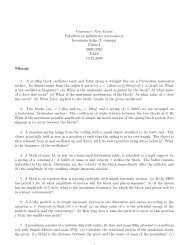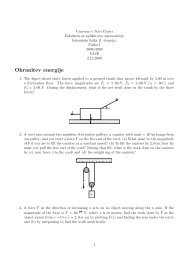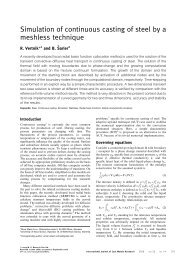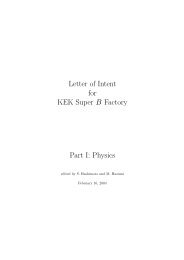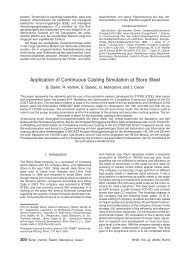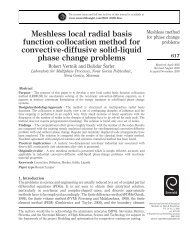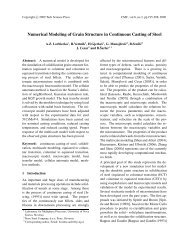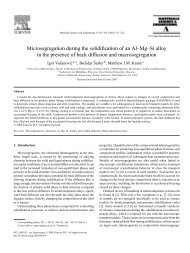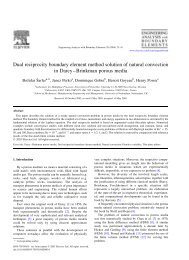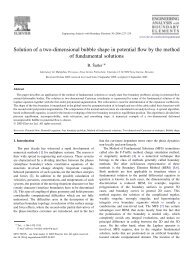Letter of Intent for KEK Super B Factory Part I: Physics
Letter of Intent for KEK Super B Factory Part I: Physics
Letter of Intent for KEK Super B Factory Part I: Physics
You also want an ePaper? Increase the reach of your titles
YUMPU automatically turns print PDFs into web optimized ePapers that Google loves.
Table 1.3: B → K ∗ γ direct CP -asymmetry<br />
CLEO (9.1 fb −1 ) (8 ± 13 ± 3) × 10 −2<br />
BaBar (20.7 fb −1 ) (−4.4 ± 7.6 ± 1.2) × 10 −2<br />
Belle (78 fb −1 ) (−0.1 ± 4.4 ± 0.8) × 10 −2<br />
Table 1.4: 90% confidence level upper limits on the B → ργ and ωγ branching fractions.<br />
ρ + γ ρ 0 γ ωγ<br />
CLEO (9.1 fb −1 ) 13 × 10 −6 17 × 10 −6 9.2 × 10 −6<br />
Belle (78 fb −1 ) 2.7 × 10 −6 2.6 × 10 −6 4.4 × 10 −6<br />
BaBar (78 fb −1 ) 2.1 × 10 −6 1.2 × 10 −6 1.0 × 10 −6<br />
matrix element Vts with Vtd. A measurement <strong>of</strong> the b → dγ process will there<strong>for</strong>e provide the<br />
ratio |Vtd/Vts| without large model dependent uncertainties. This mode is also the place where<br />
a large direct CP -asymmetry is predicted within and beyond the Standard Model.<br />
The search <strong>for</strong> the exclusive decay B → ργ is as straight<strong>for</strong>ward as the measurement <strong>of</strong><br />
B → K ∗ γ, except <strong>for</strong> its small branching fraction, the enormous combinatorial background from<br />
copious ρ mesons and random pions, and the huge B → K ∗ γ background that overlaps with<br />
the B → ργ signal window. B → ωγ is not affected by B → K ∗ γ background, but it is still<br />
unobserved. The upper limits obtained by BaBar [43], Belle [44] and CLEO [32] are summarized<br />
in Table 1.4. The upper limits are still about twice as large as the Standard Model predictions [?]<br />
(9.0 ± 3.4) × 10 −7 <strong>for</strong> ρ + γ, and (4.9 ± 1.8) × 10 −7 <strong>for</strong> ρ 0 γ and ωγ.<br />
From these upper limits the bound |Vtd/Vts| < 0.34 can be obtained, which is still weaker<br />
than the corresponding bound derived from ∆ms/∆md.<br />
1.2.4 Electroweak Rare B Decays<br />
Observation <strong>of</strong> B → K ∗ ℓ + ℓ −<br />
The first signal <strong>for</strong> B → Kℓ + ℓ − was observed by Belle [17] using 29 fb −1 <strong>of</strong> data and confirmed<br />
by BaBar [45] with 78 fb −1 , while the B → K ∗ ℓ + ℓ − signal, whose branching fraction is expected<br />
to be larger, was not significant with those data samples.<br />
The B → K (∗) ℓ + ℓ − signal is identified using Mbc, ∆E (and M(Kπ) <strong>for</strong> K ∗ ℓ + ℓ − ). Belle<br />
has updated the analysis using a 140 fb −1 data sample, with a number <strong>of</strong> improvements in<br />
the analysis procedure [18]. The most significant improvement is a lower minimum lepton<br />
momentum <strong>of</strong> 0.7 (0.4) GeV <strong>for</strong> muons (electrons) from 1.0 (0.5) GeV to gain 12% (7%) in the<br />
total efficiency. In addition, a K ∗ ℓ + ℓ − combinations are removed if there can be an unobserved<br />
photon along with one <strong>of</strong> the leptons that can <strong>for</strong>m a B → J/ψK → ℓ + ℓ − γK decay. As a result,<br />
the first B → K ∗ ℓ + ℓ − signal was observed with a statistical significance <strong>of</strong> 5.7 from a fit to Mbc,<br />
as shown in Figure 1.9, together with an improved B → Kℓ + ℓ − signal with a significance <strong>of</strong> 7.4.<br />
The branching fractions obtained are summarized in Table 1.5, together with the BaBar<br />
results [46]. For the combined B → K ∗ ℓ + ℓ − results, B(B → K ∗ ℓ + ℓ − ) = B(B → K ∗ µ + µ − ) =<br />
0.75B(B → K ∗ e + e − ) is assumed which compensates <strong>for</strong> the enhancement at the q 2 = 0 pole<br />
that appears more significantly in K ∗ e + e − , using the expected Standard Model ratio [?]. The<br />
measured branching fractions are in agreement with the Standard Model, <strong>for</strong> example [47, 48]<br />
(3.5 ± 1.2) × 10 −7 <strong>for</strong> B → Kℓ + ℓ − and (11.9 ± 3.9) × 10 −7 <strong>for</strong> B → K ∗ ℓ + ℓ − . We note that the<br />
19



